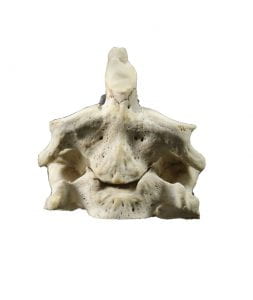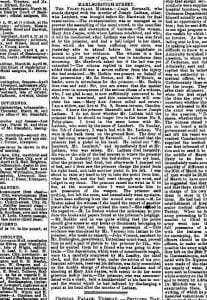Specimen of the Week 383: Fracture of the odontoid process
By ucwehlc, on 14 June 2019
This blog was written by Lily Garnett, volunteer at the UCL Pathology Museum
These human remains tell a true story of murder, attempted suicide and the understanding of mental health in 1855.
It is rare for human remains within pathology collections to bear the name of the individual they were once a part of in life. In historic collecting this is most probably due to a collector’s medical interest in a pathology as a ‘specimen’, disassociating it from the reality that it was once part of a person with feelings, thoughts and family. Moreover, in the past the maintaining of deceased individuals often went unmonitored. Until as late as a public enquiry in 1999, with a focus being on the Alder Hey Hospital in Liverpool, the vast majority were unaware that hospitals were retaining patients’ organs without consent. This ultimately led to the Human Tissue Act 2004, which is monitored by the Human Tissue Authority. Now, any institution holding human remains that are less than 100 years old since the death of an individual legally require a license.
The Foley Place Tragedy
The record of D.15 has more than just a pathological description and a number. It’s recorded as being “from a man named Latham who was shot by Burinelli in 1885”, a murder which became known as ‘The Foley Place Tragedy’ in newspaper articles across the country as the fate of Burinelli (also referred to as Buranelli) was decided.
What is known about the victim is fairly brief. Mr Joseph Latham, otherwise known as Lambert, was the son of a stock broker and he had worked as a shopkeeper at Greenwich Hospital. He married a ‘lady of property’ and then on his father’s death he acquired property in his own right. His wife and he parted, sharing out the property between them and he took up the name ‘Lambeth’. He found a new partner in Miss Elizabeth Jeanes, who is often referred to as “‘Mrs Lambeth not his wife” by the press.
Latham was killed outright with a single shot that went through his neck while asleep in bed. Elizabeth Jeanes was also shot and injured and then the gunman Buranelli turned the weapon on himself. But he aimed through his right cheek and the bullet passed upwards towards his right eye, embedding itself within his skull rather than killing him outright.
News reports from the time state that “the murdered man (Mr Latham) was interred … in a vault belonging to his family”. The fact that these two pieces of his spine are still present in the pathology collection suggest that not all of Mr Latham made it to the family vault and begs the question as to if the family were aware of this.
The additional story that these remains tell is one that is not physically visible and does not directly relate to the victim. Instead, the fact that these remains are still associated with the names of the victim and his killer means that they can be linked to written primary sources detailing the events and the resulting conviction of Buranelli. As with many murder cases, the story is complex, but one thing that does stand out during the trial of Luigi Buranelli is that he appeared to be experiencing a deterioration in his mental health.
Melancholy and delusions
Accounts suggest that Luigi Buranelli had been suffering from melancholy and delusions after the death of his wife. In his Old Bailey trial, Jane Williamson, the woman with whom he had been having a relationship around the time of the murder, mentioned that he frequently said that he wished he was dead and that he thought that medical men had injured him during a minor surgery. He had received an operation for an abscess and fistula in April 1854 and the medical practitioner questioned in court noted that “after the operation, during the time of the healing of this little wound, he became very impatient, and very violent, and very irritable, and really, eventually, unmanageable”. A nurse giving evidence at his trial said “his manner was very low and desponding, he would cry for the hour together—I would ask him what made him fret, and he would put his hand to his head, and say, “My head, my head”—in other respects he was a particularly mild and gentle man”. He was clearly suffering during his time in hospital, but because his physical wound was healing he was ordered out to make room for “a great pressure of cholera patients at the time”.
The case caused a rift between members of the medical profession and the law. Some medical professionals, such as Mitchell Henry, a surgeon at Middlesex Hospital who had cared for Buranelli during his earlier surgery insisted that he “was of no doubt that he was not of sound mind”. But others, such as Alexander John Sutherland, who was sent in to assess Buranelli during his time in prison, disagreed with this, believing instead that his illusion of ill health were down to hypochondria.
Ultimately, at the age of 32 Luigi Buranelli was found guilty and sentenced to death for the murder of Joseph Latham. His depression and melancholy were ignored and his delusions were put down to hypochondria, much to the outcry of a number of prominent medical professionals. He was publicly hanged in front of Newgate and a crowd of 4000-5000 people. In a published letter to the editor of the Morning Post, Mitchell Henry stated that “this morning was exhibited the shocking spectacle of a human being deprived of life for an act committed when the guidance of his reason had been withdrawn from him”. He goes on to say that “I venture to predict that, years hence, the result of this trial will be looked back upon with feelings of horror and amazement”.
As a society today there is still a stigma and a lack of understanding regarding mental health, even though it is now estimated that one in four people are affect by a mental illness each year (www.mqmentalhealth.org). Improvements have of course been made in recognising, diagnosing and supporting those with mental health problems since this case in 1855, but the remains of this fracture of the odontoid process caused by a bullet, allows an insight into an almost forgotten story about assessing mental health at this time.
References:
- Royal College of Psychiatrists (1885) ‘The Asylum Journal, Volume I, Issue 14 pp. 209-213 [last accessed 19/01/2019]
https://www.cambridge.org/core/journals/the-asylum-journal/article/trial-and-conviction-of-luigi-buranelli-for-murder-plea-of-insanity/72A11E79BBF9CCF48DD33CE140CB35CB - Forbes, Windslow (1855) ‘The case of Luigi Buranelli: medico-legally considered’ [last accessed 19/01/2019]
https://archive.org/details/b2044395x/page/n4 - Old Bailey Proceedings Online (April 1855) ‘Trial of Luigi Burinelli (t18550409-464)’ [last accessed 19/01/2019]
 Close
Close



